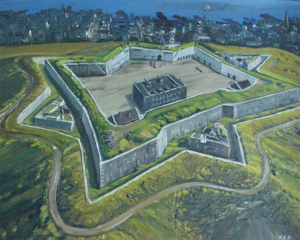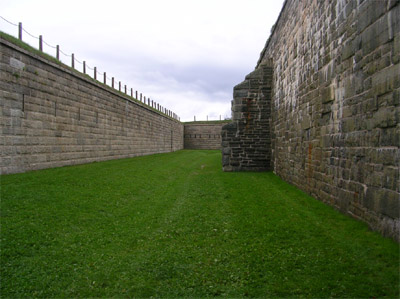 |
Halifax Citadel
Halifax, Nova Scotia
|
|
 |
Harbors, harbors, harbors. If a natural harbor was ever identified, and it wasn't in some ridiculous part of the world that nobody who was anybody in the 15th through 18th centuries cared about (Africa springs to mind), you can bet folks would be toiling mightily to fortify it.
The Mi'kmaq had been settled in what is today the northeastern US and eastern Canada long before any white people showed up. Even these Indians, who assumedly were paddling around in nothing larger than teeny little canoes, recognized an awesome harbor when they saw one. As such, they called what is today Halifax harbor Jipugtug, which means "the biggest harbor."
The French sailed over in 1604 and set about convincing the locals that Catholicism was a good idea, while simultaneously
|
 |
|
|
settling down and calling the region Acadia. French and Indian lived relatively peacefully until the British set their flinty gaze on the area, culminating in the siege of Acadia's capital, Port Royal, in 1710. The remaining French were shoved in the direction of Quebec and/or Louisiana, and on June 21 1749, 2,576 British colonists arrived at what would become Halifax harbor. The sprouting city was named for the Earl of Halifax, George Montagu-Dunk (1716-1771), President of Britain's Board of Trade, who was the sponsor of this particular undertaking.
Over the next several decades, three different fortifications were built on the hill overlooking Halifax Harbor: All were made of wood and earth, and due to constant manpower issues, they took a long time to complete, and were mostly neglected once completed. Fortunately for Britain, the only attacks made on the city were by somewhat ragtag Acadians and Indians who wanted their Acadia back (the establishment of the city of Halifax broke treaties the British had made with the Mi'kmaq in 1726)...had France or the fledgling United States made a serious effort to take the marvelous harbor in the late 18th century, there would have been little there to stop them.
|
 Halifax Citadel in 1860 Halifax Citadel in 1860 |
 |
The Halifax Citadel that we see today was built from August of 1828 to 1856, when British authorities finally realized that it was just a matter of time before those pesky Americans made a grab for the harbor. Designed and overseen by Colonel Gustavus Nicolls of the Royal Engineers, the fort is officially known as Fort George, but for goodness' sake there are so many Fort Georges (such as Fort George in Ontario, Fort George in Scotland, and Fort St. George in India, just to name the ones that are written up at Starforts.com)! Halifax Citadel is a way better name. And it was probably fortunate that Halifax had a shiny, pointy new starfort in place during the US Civil War (1861-1865), as on December 7 1863 sixteen Canadian Confederate sympathizers seized the American Steamer Chesapeake |
|
off the coast of Maine, having boarded as passengers. The sympathizers intended to use the Chesapeake as a blockade runner, defying the blockade that the US Navy had imposed on Confederate shipping in and out of Halifax Harbor.
The US Navy set off in hot pursuit, shortly catching up with the Chesapeake and escorting it back to Halifax, where the ship was impounded by the British Admiralty, and the ringleader of the fracas was helped to escape by the Confederacy's unofficial consul in Halifax (the Confederacy wasn't officially recognized by Britain, but the rebs did a great deal of business with the merchants of Halifax, thus an unofficial consul). Outrage! Saber rattling! Had Halifax Citadel not stood in its menacing fashion atop the hill, the United States Navy may well have started shooting at Halifaxian things right then 'n' there. As it was, the whole thing was chalked up as an act of piracy and generally ignored in an official capacity.
The 78th Regiment of Foot was a Scottish infantry regiment that was raised in 1793 to help bludgeon the French for their interminable warrishness. The 78th served the British crown with distinction in the Netherlands, South Africa, India and Persia and then, most likely absolutely exhausted, were shipped to Halifax in 1869 to take up residence at the Citadel. The regiment marched and bagpiped about Halifax most gloriously until it departed in 1871.
The five colonies that made up British North America united into a single country (it may have been called "Canada") in 1867. The merchants of Halifax resisted this, as Nova Scotia was doing very well financially as a relatively independent British colony, but the other, lamer colonies (Ontario, Quebec, Prince Edward Island and New Brunswick) outvoted Nova Scotia and Canada became a nation. Britain kept troops in Canada until 1906, and the Royal Navy retained control of Halifax Harbor until 1910.
|
A dizzying array of 20 separate fortifications were built at and around Halifax Harbor, starting with cannon being placed on George Island in 1750, in an effort to strengthen the harbor's defenses. Each time Great Britain became involved in yet another conflict with anyone who had ships with guns on them, frantic activity was undertaken to modernize these fortifications enough to make them actually useful in the notional defense of Halifax.
In 1798 the first Martello Tower in the western hemisphere was built as part of the Halifax Defense Complex, named Prince of Wales Tower. A Martello Tower was a low, squat tower with two levels of cannon, a design that the British |
 |
Designated are the five fortifications of the Halifax Defense Complex that remain in somewhat visitable condition today |
|
Empire busily erected in a great many threatened parts of its dominion all over the world in the late 18th and early 19th centuries.
By the end of the 19th century the Martello Tower had become nothing more than a big fat motionless target for increasingly accurate naval guns...as had indeed Halifax Citadel. Big ole batteries were needed to house the ever huger guns that were needed to fend off naval adversaries, so Fort McNab was built from 1888 to 1892. Up through the First (1914-1918) and Second (1939-1945) World Wars, Halifax Citadel was mostly used as a command center, overseeing the activities of its many better-armed satellite fortifications.
|
 The inside of Halifax Citadel today The inside of Halifax Citadel today |
 |
Today, Halifax Citadel is again guarded by the 78th Regiment of Foot, who, in their fluffy kilts and equally fluffy bearskin shakos, march and pipe their way into eternity for appreciative visitors: A Victorian era vibe is maintained throughout the fort. In 2006 the Citadel celebrated the 100th anniversary of the Canadian Armed Forces (or more accurately the 100th anniversary of the British army departing from Canada), and hosted over 1000 re-enactors from around the world.
|
|
|
|
|
|
|
 |




